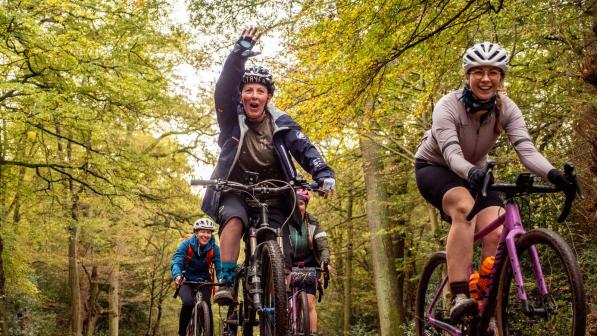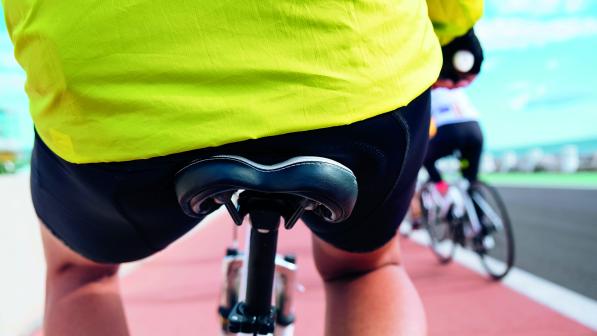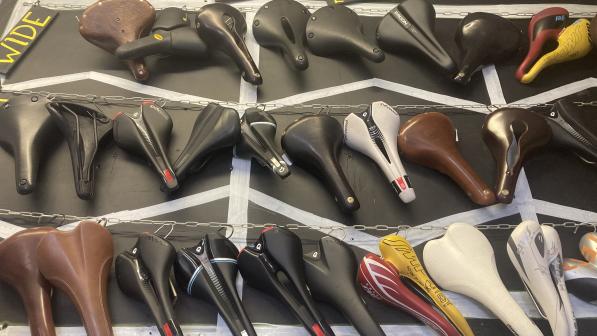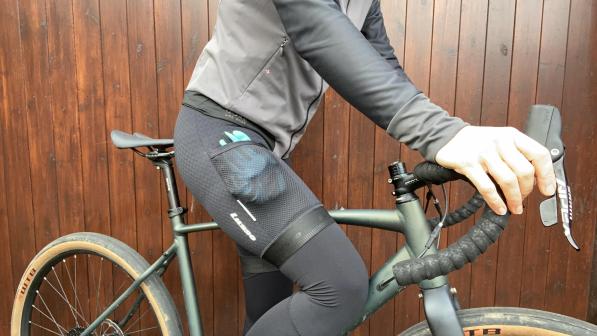Ask the expert: What can I do about saddle sores?

It was day three of riding London to Paris, when a lovely couple cycled up beside me and mentioned that despite the blazing sunshine, like-minded company and blissful days off work, there was something significantly detracting from the pure joy of the rolling roads of northern France. They both had excruciating saddle sores.
That familiar wince when a person would really rather not ever sit on a saddle ever again is unmistakable, and a feeling most of us will have experienced at some point as cyclists.
I’ve raced and ridden bikes since I was about seven years old and have been fortunate enough to become pretty familiar with what’s comfortable for me, after many, many hours in the saddle. I started running through all the reasons they might have both got into this predicament, when I realised just how many factors there are.
I asked if they’d recently changed saddle or bike set-up, if they were used to the shorts they were wearing, if they’d put clean shorts on every day, if they’d used anything anti-bacterial on their skin.
They were in fact very well versed in saddle sores and had ticked all the boxes, but what they weren’t used to was riding for several hours a day back to back, proving it can affect anyone at any time.
I sat down (ahem) with my friend and legendary physio Phil Burt, to ask him why we even get sores in the first place and what we can do about it if we do, especially if things get really bad.
To date, Phil has had a long career supporting the world’s best at three Olympic Games and seven Tour de Frances as head of physiotherapy at British Cycling, as well as five years as consultant physiotherapist at Team Sky. He is now concentrating on using his expertise to help cyclists at all levels to improve their health, comfort and performance.
He starts by mentioning the phrase ‘labial swelling’, telling me we should not be embarrassed to talk about this stuff, to which I whole-heartedly agree – a theme that will run throughout my agony aunt column. Nothing is off limits.

You’re not alone
I just bought a new saddle with a hole. No help at all. I actually think I need a new bike! JA
Hi JA,
Phil says that “25-30% of the population will always encounter some sort of saddle sore, whatever their position,” and for these people it’s about managing it as best as possible.
“Human beings are all asymmetrical, and a bike is symmetrical, so when you put these two things together you can run into problems,” he continues, explaining that the desks we sit at, the previous injuries we’ve suffered and what we do day to day can have a huge and ever-changing impact on how we sit on the saddle.
I know many people who always get their saddle sore on one side, for example. He suggests that becoming more stable off the bike through building core strength might help, while conditioning through yoga and pilates can restore some balance.
Rebecca
I am doing a challenge where I have to ride 25 miles every day over August so no rest for my derriere. Any advice on minimising chaffing on my ‘leg butt’ (the cheek undercrease)? My gear and self are washed every day and fully dried before use. Between this and the spots my bum is definitely not loving the challenge. HJ
Hi HJ,
I’ve always told people how much of a difference the seemingly simple stuff can make. Sitting around in dirty Lycra, wearing knickers under your cycling shorts, wearing shorts that are loose and moving around, can all lead to sores.
Phil reminds us that as soon as you finish cycling, you need to get out of your wet chamois, wash gently, not aggressively, and the best thing to do after that is to get air to that area. He warns us to avoid material like synthetic leggings and wear something loose and cool so things can breathe and relax.
Rebecca
I have real issues with my sit bones … I’m looking into a seat replacement and use padded shorts, but have also been told they toughen up in time. Is that right? LC
Hi LC,
“When you’re looking at skin breakdown, your tissues do toughen up and you get used to it. If you’ve been off the bike for ages and you get straight back on, it can be painful for the first couple of days, and then you get used to it again,” says Phil .“Knowing the difference between that feeling and the really problematic stuff is key.
“Shaving and waxing for women, although it’s completely your personal choice of course, can lead to problems. Having those open follicles sometimes can be a recipe for a perfect disaster for getting an infection. Some people will get saddle sore because a tiny infection takes hold around a hair follicle and you’ll get a raised lump. Leaving a little bit of hair length can help.”
A few people have said they’re concerned about saddle sore on multi-day rides. Those days when you have to get back on the bike even if it’s uncomfortable, and I’d echo Phil’s words on the ‘little things’ here. It’s so tempting to relax in your kit after you finish, especially if you’re socialising with other people, but I always make an excuse to go and at least get changed straightaway – if not shower, if possible.
You always thank yourself the next day. Standing around with your bibs pulled down off your shoulders can also lead to rubbing, as the chamois can move around where it shouldn’t. Try to find your triggers and eliminate them.
Rebecca
I’m struggling with feeling too much pressure through my coccyx. It happens about 10k in then I find I’m trying to adjust constantly to ease it. I persevere but by 20k it makes me want to get to the end quicker which is no good. Any tips would be great. Thank you, LC
Hi LC,
So how do we identify the ‘really problematic stuff’? Phil reassures us that if you’re putting in really hard effort, or you’re on the bike for four or five hours, you can expect a bit of mild discomfort and it’s OK to have a little bit of numbness, caused by too much pressure.
“If you stand out of the saddle for a few seconds the blood should rush back and it should go straight away. Stand up for 10 seconds every 10 minutes – your chamois gets to breathe, the sweat moves away, you’re sharing load between your muscles, and your blood flow and nerves get relieved of the pressure,” he explains.
However, Phil tells me that sustained numbness that isn’t going away is quite serious and could be neuropraxia (a type of peripheral nerve injury, known as the mildest form of nerve injury), which needs attention.
Another sustained problem that needs addressing is labial swelling. “It’s hard to talk about but it does happen,” says Phil. “If you’ve got a bit of tissue in the way and it’s taking on an enormous amount of pressure, the labia will swell and in the long run that’s more dangerous than the infections I referred to.
“Even if you have to go on antibiotics, an infection is easy to deal with, but chronic labial swelling can turn into quite nasty stuff and some women end up having operations. It’s not common, but if you can avoid allowing it to get to that point by being aware, we want to stop that problem before you get to surgery, as that shouldn’t be the answer.”
Rebecca
Everyone raves about Brooks saddles, but the raving comes mainly from men rather than women. Do you have any experience in using them? I get that the leather eventually moulds to your sitting bones, but how about the pressure on your soft tissue? Surely there’s no way around it unless with a cut-out section? What do you think are the best saddles for women currently? RG
Hi RG,
Saddle position can be a big factor in numbness and rubbing, so we should all get someone qualified to look at, or look at our own saddle placement. “Look at the angle of your saddle,” says Phil.
“It should never be nose up. Ever. You would not believe how two or three degrees, nose down, can really relieve discomfort and turn that saddle into the comfiest. It also brings the rear of the saddle up and supports your sit bones.”
It’s important to remember, as with anything on the bike, if you change one thing, you change everything. If in doubt don’t make huge changes before a big ride, especially multi-day.
The golden rule is, whatever it is, if it’s not going away and it’s lasting when you get off the bike, you really should be thinking about changing something and giving it some attention. Doing that on a turbo trainer can be great if you’re experimenting yourself – if you don’t like it, just get off and change it back!
Rebecca

What saddle should I buy?
I have ridden and tested pretty much every brand and saddle design out there and as much as I would love to give one definitive answer to this question, I have to say it is such an individual choice that you have to discover what works for you. It may be a little trickier with social distancing, but most brands and bike shops are very helpful with ‘try before you buy’ options, so I’d recommend looking into that.
When I first started cycling as a youngster, I didn’t have a girls’ specific saddle and things were not comfy. I’ve seen saddles evolve so much since and we’re starting to be better served as women. Having enough width for the sit bones but narrow enough not to rub has been a challenge at points, as Phil agrees.
The best thing I ever did was sit on a cushion that measured where my sit bones dented. Now, I’m sure ‘cushiony thing’ is not the technical term, but the moral of the story is that it doesn’t matter how large or small your derriere looks, you need a saddle that chimes with your sit bones, and it’s worth knowing what size you need – and that may be wider, or narrower, than you think.
“There’s a saddle fit window,” explains Phil. “There’s not one perfect position as it changes all the time. Make it specific. If you’re road riding, get a road saddle, if you’re time trialling get a saddle designed for that.
“Cut-away saddles are really easy solutions to relieve pressure, more so for men, but they can work for women. Some particular saddle designs will be perfect for 50% of women and the other will run in the other direction. That’s how individual it is. People adjust saddle height but not necessarily fore and aft. This may be the reason it doesn’t feel right, too.”
I’ve been asked a lot about Brooks saddles so I put the question to Phil, to which he answered along similar lines on individuality. “A lot of people swear by a Brooks saddle and breaking it in, and if that works for you then that’s fine, but don’t persevere with it if it’s not working for you. It’s a beautiful thing to look at and it works for some people brilliantly.”
I'm thinking of buying some padded shorts for cycling in (my bum gets uncomfortable), which ones should I get? GP
Hi GP,
Sorry to report back that it’s the same answer for this one, too. I can’t tell you what shorts are going to be the most comfortable for you. I would say you need a brand that doesn’t have unnecessary seams that could dig in, and a design that fits you really well.
Baggy Lycra will not help your skin, as it will move and rub. I find anything that takes the pressure off and gives me some air pockets of cushioning, and support where I need it, are really good. I swear by women’s-specific Assos bib shorts, I also get on very well with Wiggins by Le Col, Rapha, Katusha and budget B’twin by Decathlon.
There are many more, of course, and I haven’t worn a bad bib short in recent years, but I’d say these all serve me very well and are among my faves.
If you can afford to invest in a couple of pairs of shorts that really suit you, you won’t regret it. They’ll last if you follow the washing instructions and are a crucial contact point. Even if I was cycling in a dress to work, I’d stick a really decent pair of cycling shorts underneath to avoid any discomfort or delayed problems.
Rebecca
Chamois cream
Additionally to shorts, you might want to consider chamois cream, a cycling-specific balm designed to relieve soreness. I’ve used chamois cream sporadically over the years, and I think it can help some people more than others.
I’ve used some brilliant products from brands such as Assos – they’re luxurious and definitely help you get back on the bike day after day. I also see nothing wrong with smothering on some Sudocrem from the local pharmacy.
Over to Phil for the science: “Chamois cream isn’t nirvana, but it helps reduce friction and keeps your skin relatively clean and healthy. It’s a bit of a stupid word really, as we don’t put it on the chamois anymore – we put it on ourselves.
“That area quite often gets damp. Your skin isn’t happy if it’s hot, wet and under pressure – that’s the perfect scenario for saddle sores. Look for the best emolium – the slipperiest thing and make sure it stays around. If it disappears after five minutes, it’s not going to help you in the long run if it’s too watery. The main purpose of it is to stop water getting into your skin.”
After your ride, Phil says it’s all about getting clean and moisturised – but what’s the best product to use?
“Sudocrem is a moisturiser with some antiseptic properties in there. Cosmetics and sports balms can be hard to navigate, so keep it simple. You can always save your money and go straight for medical grade dry skin moisturiser.
“You want your skin PH to be as neutral as possible. Simple cleaning and getting air to that area is the most important thing.”

Thank you to everyone for writing in and please keep your questions and comments coming, I’m over on @beccacharlton_insta on Instagram, and big thanks to Phil Burt for his insight, you can follow him on Instagram @philburtinnov.











